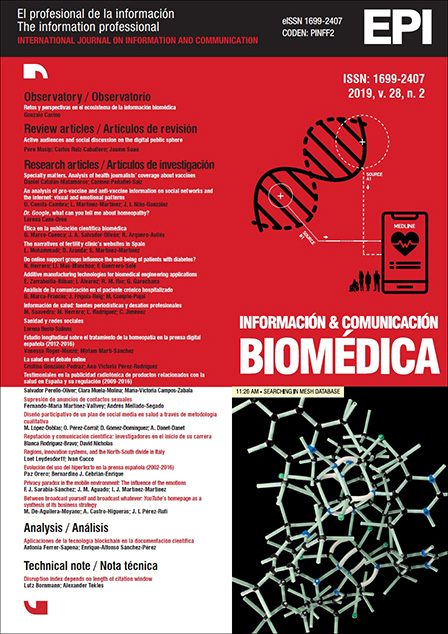Entre broadcast yourself y broadcast whatever: la página de inicio de YouTube como síntesis de su estrategia empresarial
Keywords:
YouTube, Contenido audiovisual, Vídeo, Vídeo online, Algoritmos, Youtubers, Contenido generado por el usuario, Industrias culturales y creativas, Modelos de negocio.Abstract
YouTube es una empresa representativa de su contexto originario, la web 2.0, posicionándose como plataforma abierta y colaborativa para difundir vídeos de todo tipo de usuario, con el slogan Broadcast yourself. La adquisición de YouTube por Google la introduce en la búsqueda de beneficios en el marco de la comunicación OTT (over the top). La página de inicio de YouTube muestra las sucesivas políticas empresariales de la plataforma. Se analiza la evolución de la página de inicio no logueada de YouTube España entre 2009 y 2018. Se observa la gradual desaparición de los vídeos producidos por usuarios particulares y su sustitución por los vídeos de usuarios profesionalizados (youtubers) y de industrias culturales. Hay un notable paralelismo entre la implementación de modelos de negocio y la mayor o menor recomendación de vídeos de uno u otro tipo.
Downloads
References
Alexa (2018). The top 500 sites on the web. https://www.alexa.com/topsites
Arthurs, Jane; Drakopoulou, Sophia; Gandini, Alessandro (2018). "Researching YouTube". Convergence, v. 24, n. 1, pp. 3-15. https://doi.org/10.1177/1354856517737222
Bí¤rtl, Mathias (2018). "YouTube channels, uploads and views: A statistical analysis of the past 10 years". Convergence: The international journal of research into new media technologies, v. 24, n. 1, pp. 16-32.
https://doi.org/10.1177/1354856517736979
Burgess, Jean; Green, Joshua (2009). YouTube: online video and participatory culture. Cambridge, Medford: Polity Press. ISBN: 978 0 745644790
Burgess, Jean; Green, Joshua (2018). YouTube: online video and participatory culture, 2nd ed. Cambridge, Medford: Polity Press. ISBN: 978 0 745 66018 9
Cunningham, Stuart; Craig, David (2017). "Being "˜really real´ on YouTube: authenticity, community and brand culture in social media entertainment". Media international Australia, v. 164, n. 1, pp. 71-81. https://doi.org/10.1177/1329878X17709098
Cunningham, Stuart; Craig, David; Silver, Jon (2016). "YouTube, multichannel networks and the accelerated evolution of the new screen ecology". Convergence, v. 22, n. 4, pp. 376-391. https://doi.org/10.1177/1354856516641620
De-Aguilera-Gamoneda, Joaquín; De-Aguilera-Moyano, Miguel (1989). Nueva dimensión de los medios audiovisuales. Barcelona: Mitre. ISBN: 978 84 7652 041 3
Elías, Carlos (2015). El selfie de Galileo. Software social, político e intelectual del siglo XXI. Barcelona: Península. ISBN: 978 84 9942 424 8
Gehl, Robert (2009). "YouTube as archive. Who will curate this digital Wunderkammer?". International journal of cultural studies, v. 12, n. 1, pp. 43-60. https://doi.org/10.1177/1367877908098854
Holland, Margaret (2016). "How YouTube developed into a successful platform for user-generated content". Elon journal of undergraduate research in communications, v. 7, n. 1, pp. 52-59. https://www.elon.edu/u/academics/communications/journal/wp-content/uploads/sites/153/2017/06/06_Margaret_Holland.pdf
Internet Archive (2018). Wayback Machine. https://archive.org/web
Kim, Jin (2012). "The institutionalization of YouTube: From user generated content to professionally generated content". Media, culture & society, v. 34, n. 1, pp. 53-67. https://doi.org/10.1177/01634437114271
Kitchin, Rob (2018). "Thinking critically about and researching algorithms". In: Beer, David (ed.). The social power of algorithms. New York: Sage, pp. 14-29. ISBN: 978 0 81539 183 8
Leadbeater, Charles; Miller, Paul (2004). The pro-am revolution: How enthusiasts are changing our society and economy. London: Demos. ISBN: 978 1 84180 136 0
Lobato, Ramón (2016). "The cultural logic of digital intermediaries: YouTube multichannel networks". Convergence: The international journal of research into new media technologies, v. 22, n. 4, pp. 348-360. https://doi.org/10.1177/1354856516641628
Park, Minsu; Park, Jaram; Baek, Young-Min; Macy, Michael (2017). "Cultural values and crosscultural video consumption on YouTube". PLoS one, v. 12, n. 5, e0177865. https://doi.org/10.1371/journal.pone.0177865
Patel, Sahil (2017). "Inside Disney´s troubled $675 mil. Maker Studios acquisition". Digiday UK, 22 February. https://digiday.com/media/disney-maker-studios
Poel, Thomas; Nieborg, David B.; Duffy, Brooke-Erin; Prey, Robert (2017). "The platformization of cultural production". In: 18th Annual conference of the Association of Internet Research, Tartu, Estonia, 18-21 October. http://platformization.net/wp-content/uploads/2018/09/AoIR2017-Platformization-of-Cultural-Production.pdf
Postigo, Hector (2014). "The socio-technical architecture of digital labor: Converting play into YouTube money". New media & society, v. 18, n. 2, pp. 332-349. https://doi.org/10.1177/1461444814541527
Prado, Emili (2017). "El audiovisual on line over the top. El futuro del audiovisual europeo y español". In: Bustamante, Enrique (coord.). Informe sobre el estado de la cultura en España. Igualdad y diversidad en la era digital. Madrid: Fundación Alternativas, pp. 127-144. ISBN: 987 84 15860 66 2
Prey, Robert (2016). "Musica analytica: The datafication of listening". In: Nowak, Raphaí«l; Whelan, Andrew (eds.). Networked music cultures. London: Palgrave Macmillan UK, pp. 31-48. ISBN: 978 1 137 58290 4 https://doi.org/10.1057/978-1-137-58290-4_3
Rieder, Bernhard; Matamoros-Fernández, Ariadna; Coromina, í’scar (2018). "From ranking algorithms to "˜ranking cultures´: Investigating the modulation of visibility in YouTube search results". Convergence: The international journal of research into new media technologies, v. 24, n. 1, pp. 50-68. https://doi.org/10.1177/1354856517736982
Rogers, Richard (2015). Digital methods. MIT Press: Cambridge (MA). ISBN: 978 0 26252 824 5
Silver, David (2008). "History, hype and hope". First Monday, v. 13, n. 3. http://firstmonday.org/article/view/2143/1950
Singleton, Micah (2016). "YouTube is still having trouble getting people to pay for YouTube". The verge, 2 November. https://www.theverge.com/2016/11/2/13498470/youtube-red-subscribers-video-content-music
Thrift, Nigel (2006). Knowing capitalism. London: Sage. ISBN: 978 1 41290 059 1
Winkler, Rolfe (2015). "YouTube: 1 billion viewers, no profit". The Wall Street Journal, 25 February. https://www.wsj.com/articles/viewers-dont-add-up-to-profit-for-youtube-1424897967
YouTube (2018). Ayuda de YouTube. https://support.google.com/youtube/answer/2579942?hl=en-419
Downloads
Additional Files
Published
How to Cite
Issue
Section
License
Dissemination conditions of the articles once they are published
Authors can freely disseminate their articles on websites, social networks and repositories
However, the following conditions must be respected:
- Only the editorial version should be made public. Please do not publish preprints, postprints or proofs.
- Along with this copy, a specific mention of the publication in which the text has appeared must be included, also adding a clickable link to the URL: http://www.profesionaldelainformacion.com
- Only the final editorial version should be made public. Please do not publish preprints, postprints or proofs.
- Along with that copy, a specific mention of the publication in which the text has appeared must be included, also adding a clickable link to the URL: http://revista.profesionaldelainformacion.com
Profesional de la información journal offers the articles in open access with a Creative Commons BY license.




